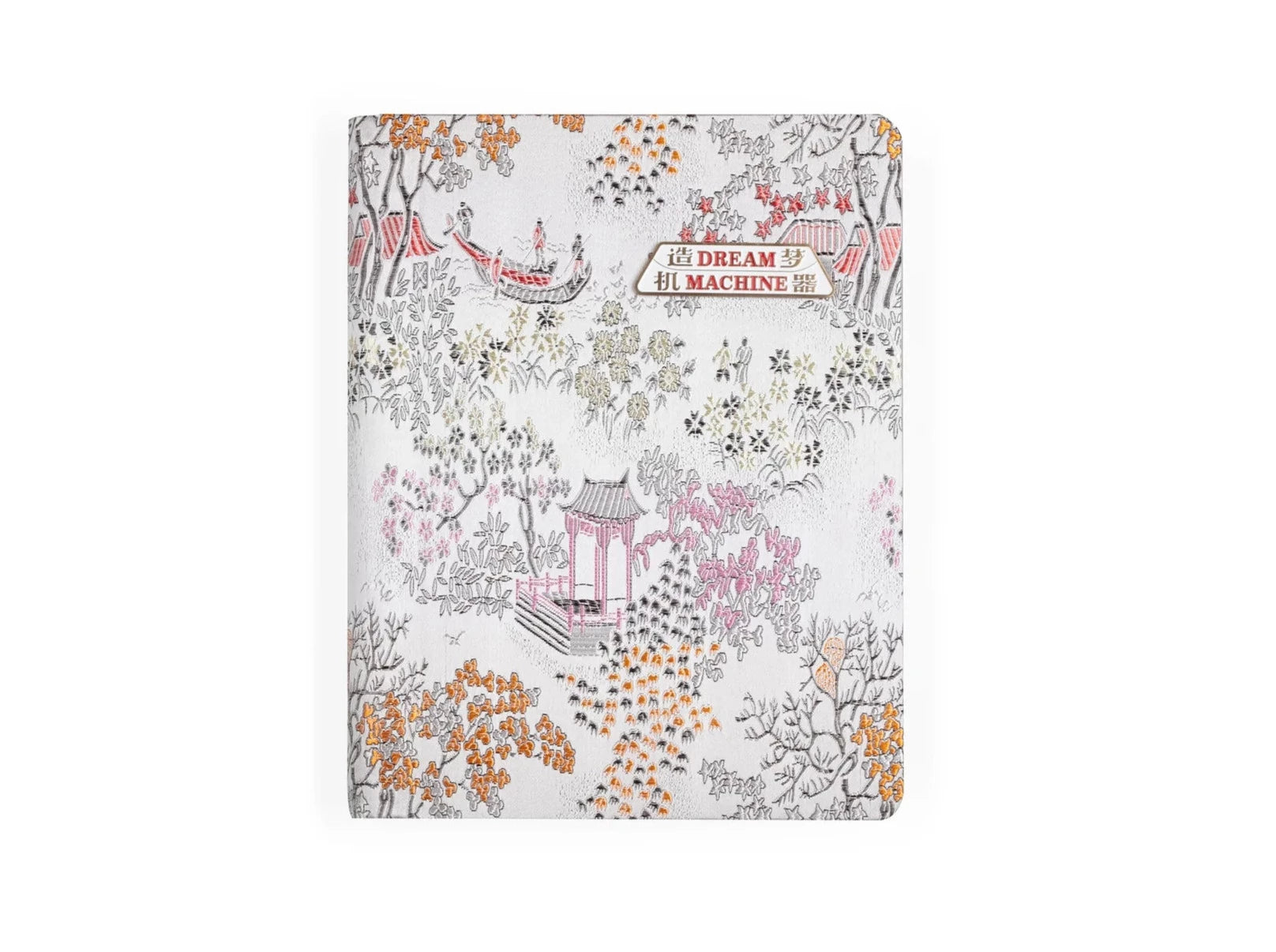










180×255 mm | 68頁 | リング装ハードカバー
本作品集はインターネット上のショップで見つけられた、どこか懐かしく、中国らしさを感じられるデザインの布がまとわれている1冊となっている。
戦前の中国で撮影された写真(複製)が色とりどりかつイラストが描かれたページに配置されているが、どこか現代的な感覚を感じられる。
美しく、手に取って楽しい1冊である。
--
中国に初めて自動車がやってきたとき、私たちはどれほど感動したことでしょう。100年以上前、都会人や普通の農民は、人知れず動く不思議な乗り物に見とれていたに違いない。ある人は「悪霊が乗っている」と言った。しかしその昔、カメラと魔法の鏡が発明されたときにも、同じようなことが言われていた。また少しユーモアのセンスのある人は、自動車のことを「外国の家歩き」と呼んだり、背後の空気に溶け込んだ黒い煙から「屁こきカート」と呼んだりした。
しかし、1900年代初頭まで中国の人々が外国製品や近代化に敵対していた、と考えるのはよくある間違いです。一般的に言えば、彼らは新しいトレンドを積極的に受け入れ、それを日常生活の中に実用的に織り込んでいったのである。高級な輸入品はエリートが社会的地位を示す視覚的証拠として使用し、安価な模造品は一般庶民の新製品への需要を満たした。両者は、有形物を必要とせず、新しいものを切望する文化に吸収された[1] 。
例えば杭州では、西湖の大群衆が写真のスライドショーに驚嘆した。1930年代、街には何十人もの写真家がいました。当時、一般庶民は白黒で、裕福な人は手作業で丹念に彩色されたポートレイトを撮影した。写真館では背景をペンキで塗りつぶした風景や、流行りの機械を前景に、モダンな雰囲気を再現することに努めた。1940年代のオートバイ、1950年代の戦車、1960年代の飛行機、1980年代のテレビなど、新しい技術への憧れは、現在でも感じられる継続的な文化習慣であることが証明されています。
この作品集では、私が過去10年間に中国の骨董市やウェブサイトを通じて収集した35枚の写真で構成されています。カラフルなグラフィックは、1960年代に制作された、有名な西湖のほとりで歴史的な旅をするアルバムからコピーしたものです。ポートレートは、かつて車や飛行機、テレビなどの機械が持っていた未来的な魅力を表現しています。ここ数十年のインターネット、スマートフォン、電動バイクの発明のように、ほとんどの革新的な技術は、ゆっくりと一般的な姿へとなっていくのです。
ーーアーティストステートメント
[1] フランク・ディケッター『エキゾチック・コモディティ、モダン・オブジェと中国の日常生活』コロンビア大学出版局、ニューヨーク、2006年
We can only imagine how mind-blowing it would have been to have witnessed the arrival of the first ever automobiles in China. Over a century ago, city folk and ordinary farmers must have stopped whatever they were doing to admire the mysterious vehicle which moved seemingly without human effort. Some said it was driven by ‘evil spirits’. But then, they had said the same about the invention of the camera and its magic mirror years before. Others, with a slightly better sense of humour, called it a ‘foreign house walking’, or even wittier, a ‘fart cart’, for the black smoke that invariably dissolved into the air behind it.
It’s a common mistake however to believe that by the early 1900s, the Chinese population was hostile towards foreign products or modernity. Generally speaking, they enthusiastically embraced new trends that were then pragmatically woven into the fabric of everyday life. Luxury imports were used by elites as visual evidence of social status, while cheap imitations satisfied the demand for new products among ordinary people: both were absorbed into a culture that without the tangible and craved the new. [1]
In Hangzhou for example, large crowds at the West Lake marveled at photographic slide shows demonstrating that ‘the eyes can take the audience to many places’. By the 1930s, the city had dozens of photographers. Ordinary people could have their portrait taken in black and white while those with more cash had theirs painstakingly tinted by hand. Inside the photo studio, efforts were made to recreate a modern atmosphere with painted landscape backgrounds and foregrounds of the latest machinery in fashion. From the first motorcycles in the 1940s, to tanks in the 1950s, planes in the 1960s and televisions in the 1980s, the eagerness for new technology has proven to be a continuous cultural habit that can still be felt today.
This album consists of 35 photographs I collected at antique markets and via websites in China over the past decade. The colourful graphics are copied from an album originally produced in the 1960s which offers a historical tour along the banks of the famous West Lake. The portraits capture the futuristic appeal that machines like cars, planes or televisions once had. Like the invention of the internet, smartphone or e-bike in recent decades, most innovations slowly slip away into the common present.
ーーRuben Lundgren
[1] Frank Dikötter, Exotic Commodities, Modern Objects and Everyday Life in China, Columbia University Press, New York, 2006
-
Ruben Lundgren/ルーベン・ルンドグレン
北京を拠点に活動する写真家、キュレーターのルーベン・ルンドグレンは、2011年に中国中央美術学院を卒業。コンセプチュアルな写真家デュオ「WassinkLundgren」の一員として、「Empty Bottles」(2007)、「Tokyo Tokyo」(2010)などを発表し、その名を知られるようになった。2013年、FOAMで彼らの作品の回顧展を開催。
オランダの新聞「De Volkskrant」のフォトジャーナリストとして、また中国写真のインディペンデントキュレーターとして活動。Martin Parrとともに『The Chinese Photobook』(2015)を共同編集。その他の著書に『Hlleo?』(2018)、中国のヴァナキュラーフード写真の美味しいコレクション『MeNu』(2018)がある。BredaPhoto 2020のゲストキュレーターとして、ステッカーアルバム「Wow Taobao」を含む中国からの24の現代写真プロジェクトを提示した「China Imagined」展をキュレーションした。2021年には『Ellen Thorbecke』の編集を担当、 また中国全土で撮影されたジャーナリスティックな作品を収録した『Real Dreams』を出版した。
彼の写真や書籍は個人・公的コレクションに多数収集されており、FOAM写真美術館(アムステルダム)、The Archive of Modern Conflict(ロンドン)、Ullens Centre for Contemporary Art(北京)など国際的なギャラリーや美術館でも展示されている。
Beijing based photographer and curator Ruben Lundgren graduated from China Central Academy of Fine Arts in 2011. He made a name within the conceptual photography duo WassinkLundgren with publications as Empty Bottles (2007) and Tokyo Tokyo (2010). FOAM showed a retrospect of their work in 2013.
He works as a photojournalist for Dutch newspaper De Volkskrant and as an independent curator of Chinese photography. Together with Martin Parr he co-edited The Chinese Photobook (2015). Other publications include Hlleo? (2018) and MeNu (2018) a tasty collection of Chinese vernacular food photography. As a guest curator of BredaPhoto 2020 he curated China Imagined offering 24 contemporary photography projects from China including the sticker album Wow Taobao. In 2021 he edited the book Ellen Thorbecke: From Peking to Paris, and published Real Dreams with his journalistic works made all over China.
His photographs and books are collected by various private and public collections and have also been exhibited at international galleries and museums including FOAM photography museum (Amsterdam), The Archive of Modern Conflict (London) and Ullens Centre for Contemporary Art (Beijing).
